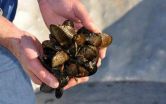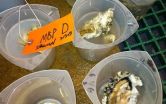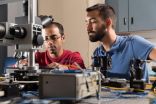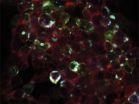(Press-News.org) The mortality of larval Pacific oysters in Northwest hatcheries has been linked to ocean acidification. Yet the rate of increase in carbon dioxide in the atmosphere and the decrease of pH in near-shore waters have been questioned as being severe enough to cause the die-offs.
Now, a new study of Pacific oyster and Mediterranean mussel larvae found that the earliest larval stages are sensitive to saturation state, rather than carbon dioxide (CO2) or pH (acidity) per se.
Saturation state is a measure of how corrosive seawater is to the calcium carbonate shells made by bivalve larvae, and how easy it is for larvae to produce their shells. A lower saturation rate is associated with more corrosive seawater.
Increasing CO2 lowers saturation state, the researchers say, and saturation state is very sensitive to CO2.
The scientists used unique chemical manipulations of seawater to identify the sensitivity of saturation state for larval bivalves such as mussels and oysters.
Results of the study, which was funded by the National Science Foundation (NSF), are reported this week in the journal Nature Climate Change.
"Biological oceanographers have speculated that early life stages of marine organisms might be particularly sensitive to ocean acidification, but the underlying mechanisms remain unknown for most species," says David Garrison, program director in NSF's Division of Ocean Sciences, which funded the research through an ocean acidification competition.
NSF's Directorates for Geosciences and for Biological Sciences supported the ocean acidification awards.
"This research is an important step," says Garrison, "in being able to predict, and perhaps mitigate, the effects of ocean acidification on coastal resources."
Commercial hatchery failures
The findings help explain commercial hatchery failures, and why improving water chemistry in those hatcheries has been successful.
Shellfish hatcheries are now altering water chemistry to create more favorable saturation state conditions for young bivalves.
"Bivalves have been around for a long time and have survived different geologic periods of high carbon dioxide levels in marine environments," says George Waldbusser, an Oregon State University (OSU) marine ecologist and biogeochemist and lead author of the paper.
"The difference is that in the past, alkalinity (the opposite of acidity) levels buffered increases in CO2, which kept the saturation state higher relative to pH. In the present ocean, the processes that contribute buffering to the ocean cannot keep pace with the rate of CO2 increase.
"As long as the saturation state is high, the oysters and mussels we tested could tolerate CO2 concentrations almost 10 times what they are today."
The idea that bivalve development and growth is not as linked to CO2 or pH levels as previously thought initially seems positive.
However, the reverse is true, Waldbusser says.
Larvae sensitive to saturation state
Larval oysters and mussels are so sensitive to the saturation state (which is lowered by increasing CO2) that the threshold for danger will be crossed "decades to centuries," says Waldbusser, ahead of when CO2 increases (and pH decreases) alone would pose a threat to bivalve larvae.
"At the current rate of change, there is not much more room for the waters off the Oregon coast, for example, to absorb more CO2 without crossing the threshold," Waldbusser says.
The study builds on previous research by Waldbusser and colleagues that outlined the mechanisms by which young bivalves create their shells after fertilization.
The researchers found that young oysters and mussels build their shells within 48 hours to successfully begin feeding at a rate fast enough to survive, and that the rate of shell-building required significant energy expenditures.
In the presence of acidic water, the oysters and mussels had to divert too much energy to shell-building and lacked the energy to swim and get food.
Sinking shellfish
"The hatcheries call it 'lazy larvae syndrome' because these tiny oysters just sink in the water and stop swimming," Waldbusser says.
"These organisms have really sensitive windows to ocean acidification--even more sensitive than we thought."
In the current study, the researchers used high-resolution images to analyze the development of oyster and mussel shells.
They found that the organisms--which are about 1/100th the diameter of a human hair--build a complete calcium carbonate shell within six hours, about 12 hours after fertilization.
Alter the ocean chemistry just a bit, however, and a greater proportion of the shells do not develop normally.
The ones that do are smaller, leading to potentially weaker organisms that take longer to get to a size where they can settle into adult life.
"When the water is more saturated and has greater alkalinity it helps offset higher levels of carbon dioxide, ensuring that shell formation can proceed--and also making the shells bigger," Waldbusser says. "This can have a significant effect on their survivability."
INFORMATION:
Other OSU researchers involved in the work include Burke Hales, Chris Langdon, Brian Haley, Paul Schrader, Elizabeth Brunner, Matthew Gray, Cale Miller and Iria Gimenez.
Being "average" is often considered a bad thing, but new research suggests that averageness wins when people assess the trustworthiness of a face. The research indicates that, while typical-looking faces aren't seen as the most attractive, they are considered to be the most trustworthy. The new findings are published in Psychological Science, a journal of the Association for Psychological Science.
"Face typicality likely indicates familiarity and cultural affiliation - as such, these findings have important implications for understanding social perception, including cross-cultural ...
ITHACA, N.Y. - Since 1998, hundreds and sometimes thousands of dead eider ducks have been washing up every year on Cape Cod's beaches in late summer or early fall, but the reasons behind these cyclic die-offs have remained a mystery.
A team of scientists from Cornell, Tufts University, University of Georgia, the U.S. Geological Survey and the U.S. Fish and Wildlife Service have pinned down one of the agents responsible: a pathogen they're calling Wellfleet Bay virus (WFBV). Their findings shed light on why eider ducks (also called common eiders) die on Cape Cod every ...
NEW YORK, NY -- Researchers at NYU Langone Medical Center have developed new technology that can assess the location and impact of a brain injury merely by tracking the eye movements of patients as they watch music videos for less than four minutes, according to a study published Friday on-line in the Journal of Neurosurgery.
The study suggests that the use of eye tracking technology may be a potential biological marker for assessing brain function and monitoring recovery for patients with brain injuries.
Led by Uzma Samadani, MD, PhD, chief of neurosurgery at New ...
GALVESTON, Texas -- In the largest study to date evaluating outcomes of Hispanic women with endometrial uterine cancer, researchers at the University of Texas Medical Branch at Galveston have found that Hispanic women in the United States were significantly less likely to survive the cancer than non-Hispanic white women.
A total of 69,764 women diagnosed with endometrial cancer between 2000 and 2010 were included in this study of public-use data from the National Cancer Institute's Surveillance, Epidemiology, and End Results Program. The study is available online in the ...
A team of researchers from the University of California, San Diego have demonstrated a way to emit and control quantum light generated using a chip made from silicon--one of the most widely used materials for modern electronics.
The UC San Diego researchers recently described their new device's performance online in the journal Nature Communications, available via Open Access .
The researchers say practical applications of quantum optics will seem more feasible if devices for generating and controlling these photons can be manufactured using conventional materials ...
It's the most basic of ways to find out what something does, whether it's an unmarked circuit breaker or an unidentified gene -- flip its switch and see what happens. New remote-control technology may offer biologists a powerful way to do this with cells and genes.
A team at Rockefeller University and Rensselaer Polytechnic Institute is developing a system that would make it possible to remotely control biological targets in living animals -- rapidly, without wires, implants or drugs.
Today (December 15) in the journal Nature Medicine, the team describes successfully ...
BOSTON (Dec. 16, 2014) -- Extra vitamin E protected older mice from a bacterial infection that commonly causes pneumonia. Microbiologists and nutrition researchers from Tufts University report that the extra vitamin E helped regulate the mice's immune system. The findings, published online in advance of print in the The Journal of Immunology, show promise for studies investigating the effects of vitamin E and infection in humans.
Older adults over age 65 are at high risk for developing pneumonia, an inflammation of the lungs typically caused by infection. The most common ...
A scientific team at UBC and Providence Health Care have genetically engineered mice with less wrinkled skin, despite repeated exposure to wrinkle-inducing ultraviolet (UV) light.
The youthful-looking mice were bred without the gene that produces Granzyme B, an enzyme that immune cells use to destroy harmful pathogens. The UBC-Providence team, led by Professor David Granville and postdoctoral fellow Leigh Parkinson, found that Granzyme B also does harm: When produced and released by skin cells in response to UV light, it triggers the breakdown of collagen, a structural ...
ANN ARBOR--A set of eight hurricane-forecast satellites being developed at the University of Michigan is expected to give deep insights into how and where storms suddenly intensify--a little-understood process that's becoming more crucial to figure out as the climate changes, U-M researchers say.
The Cyclone Global Navigation Satellite System is scheduled to launch in fall 2016. At the American Geophysical Union Meeting in San Francisco this week, U-M researchers released estimates of how significantly CYGNSS could improve wind speed and storm intensity forecasts.
CYGNSS--said ...
Contrary to popular belief, new research suggests that some employees adapt well to pressures caused by changes in the workplace.
Pay cuts, reduced working hours, fewer training and promotion opportunities are just a few of the measures organisations employ to combat economic downturn and industry competition. Where previous research has suggested cut backs result in a demotivated and unhappy workforce, experts from Monash University and The University of Iowa say this might not necessarily be the case.
A new study published in the Journal of Occupational and Organizational ...







